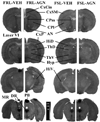AGN-2979, an inhibitor of tryptophan hydroxylase activation, does not affect serotonin synthesis in Flinders Sensitive Line rats, a rat model of depression, but produces a significant effect in Flinders Resistant Line rats
- PMID: 19463878
- PMCID: PMC2778282
- DOI: 10.1016/j.neuint.2009.05.008
AGN-2979, an inhibitor of tryptophan hydroxylase activation, does not affect serotonin synthesis in Flinders Sensitive Line rats, a rat model of depression, but produces a significant effect in Flinders Resistant Line rats
Abstract
The neurotransmitter, serotonin, is involved in several brain functions, including both normal, physiological functions, and pathophysiological functions. Alterations in any of the normal parameters of serotonergic neurotransmission can produce several different psychiatric disorders, including major depression. In many instances, brain neurochemical variables are not able to be studied properly in humans, thus making the use of good animal models extremely valuable. One of these animal models is the Flinders Sensitive Line (FSL) of rats, which has face, predictive and constructive validities in relation to human depression. The objective of this study was to quantify the effect of the tryptophan hydroxylase (TPH) activation inhibitor, AGN-2979, on the FSL rats (rats with depression-like behaviour), and compare it to the effect on the Flinders Resistant Line (FRL) of rats used as the control rats. The effect was evaluated by measuring changes in regional serotonin synthesis in the vehicle treated rats (FSL-VEH and FRL-VEH) relative to those measured in the AGN-2979 treated rats (FSL-AGN and FRL-AGN). Regional serotonin synthesis was measured autoradiographically in more than 30 brain regions. The measurements were performed using alpha-[(14)C]methyl-l-tryptophan as the tracer. The results indicate that AGN-2979 did not produce a significant reduction of TPH activity in the AGN-2979 group relative to the vehicle group (a reduction would have been observed if there had been an activation of TPH by the experimental setup) in the FSL rats. On the other hand, there was a highly significant reduction of synthesis in the FRL rats treated by AGN-2979, relative to the vehicle group. Together, the results demonstrate that in the FSL rats, AGN-2979 does not affect serotonin synthesis. This suggests that there was no activation of TPH in the FSL rats during the experimental procedure, but such activation did occur in the FRL rats. Because of this finding, it could be hypothesized that TPH in the FSL rats cannot be easily activated. This may contribute to the development of depressive-like symptoms in the FSL rats ("depressed" rats), as they cannot easily modulate their need for elevated amounts of this neurotransmitter, and possibly other neurotransmitters. Further, because these rats represent a very good model of human depression, one can hypothesize that humans who do not have readily activated TPH may be more prone to develop depression.
Figures


 indicates the regions in which AGN-2979 produced a significant effect in FRL rats following FDR correction. The effects in all of the brain regions of SPD rats, used as comparisons, were significant (Hasegawa et al. 2005).
indicates the regions in which AGN-2979 produced a significant effect in FRL rats following FDR correction. The effects in all of the brain regions of SPD rats, used as comparisons, were significant (Hasegawa et al. 2005).Similar articles
-
Chronic citalopram treatment elevates serotonin synthesis in flinders sensitive and flinders resistant lines of rats, with no significant effect on Sprague-Dawley rats.Neurochem Int. 2009 May-Jun;54(5-6):363-71. doi: 10.1016/j.neuint.2009.01.005. Neurochem Int. 2009. PMID: 19418630 Free PMC article.
-
The tryptophan hydroxylase activation inhibitor, AGN-2979, decreases regional 5-HT synthesis in the rat brain measured with alpha-[14C]methyl-L-tryptophan: an autoradiographic study.Brain Res Bull. 2005 Oct 15;67(3):248-55. doi: 10.1016/j.brainresbull.2005.07.009. Brain Res Bull. 2005. PMID: 16144662
-
Brain 5-HT synthesis in the Flinders Sensitive Line rat model of depression: an autoradiographic study.Neurochem Int. 2006 Apr;48(5):358-66. doi: 10.1016/j.neuint.2005.11.012. Epub 2006 Jan 19. Neurochem Int. 2006. PMID: 16427159
-
Administration of antidepressants, diazepam and psychomotor stimulants further confirms the utility of Flinders Sensitive Line rats as an animal model of depression.Psychopharmacology (Berl). 1995 Sep;121(1):27-37. doi: 10.1007/BF02245589. Psychopharmacology (Berl). 1995. PMID: 8539339 Review.
-
The Flinders sensitive line rats: a genetic animal model of depression.Neurosci Biobehav Rev. 1993 Spring;17(1):51-68. doi: 10.1016/s0149-7634(05)80230-1. Neurosci Biobehav Rev. 1993. PMID: 8455816 Review.
Cited by
-
PET imaging of animal models with depressive-like phenotypes.Eur J Nucl Med Mol Imaging. 2023 May;50(6):1564-1584. doi: 10.1007/s00259-022-06073-4. Epub 2023 Jan 16. Eur J Nucl Med Mol Imaging. 2023. PMID: 36642759 Free PMC article. Review.
References
-
- Adell A, Garcia-Marquez C, Armario A, Gelpi E. Chronic stress increases serotonin and noradrenaline in rat brain and sensitizes their responses to a further acute stress. Journal of Neurochemistry. 1988;50:1678–1681. - PubMed
-
- Andersen ML, Bignotto M, Machado RB, Tufik S. Different stress modalities result in distinct steroid hormone responses by male rats. Brazilian Journal of Medical and Biological Research. 2004;37:791–797. - PubMed
-
- Andrade R, Malenka RC, Nicoll RA. A G protein couples serotonin and GABAB receptors to the same channels in hippocampus. Science. 1986;234(4781):1261–1265. - PubMed
-
- Anisman H, Matheson K. Stress, depression, and anhedonia: caveats concerning animal models. Neuroscience and Biobehavioral Physiology Rev. 2005;29:525–546. Review. - PubMed
-
- Bhagwagar Z, Hinz R, Taylor M, Fancy S, Cowen P, Grasby P. Increased 5-HT(2A) receptor binding in euthymic, medication-free patients recovered from depression: a positron emission study with [(11)C]MDL 100,907. American Journal of Psychiatry. 2006;163(9):1580–1587. - PubMed
Publication types
MeSH terms
Substances
Grants and funding
LinkOut - more resources
Full Text Sources
Medical

